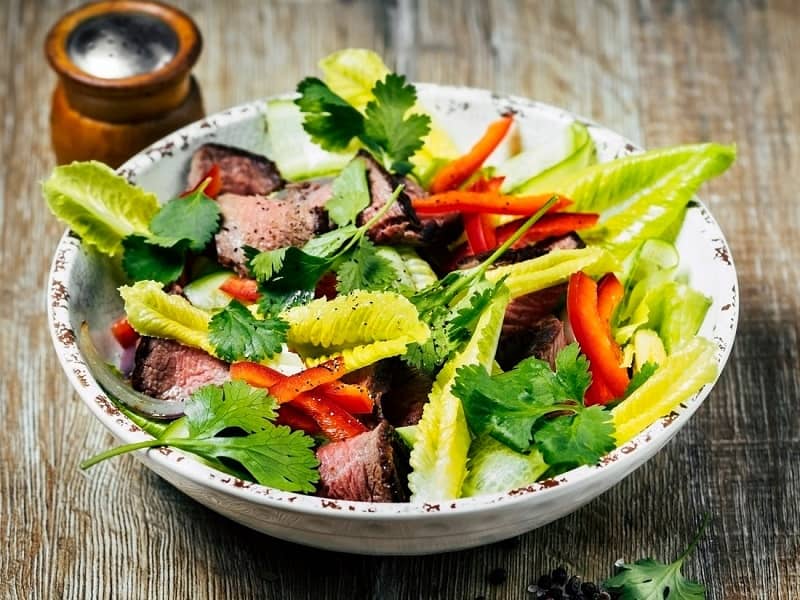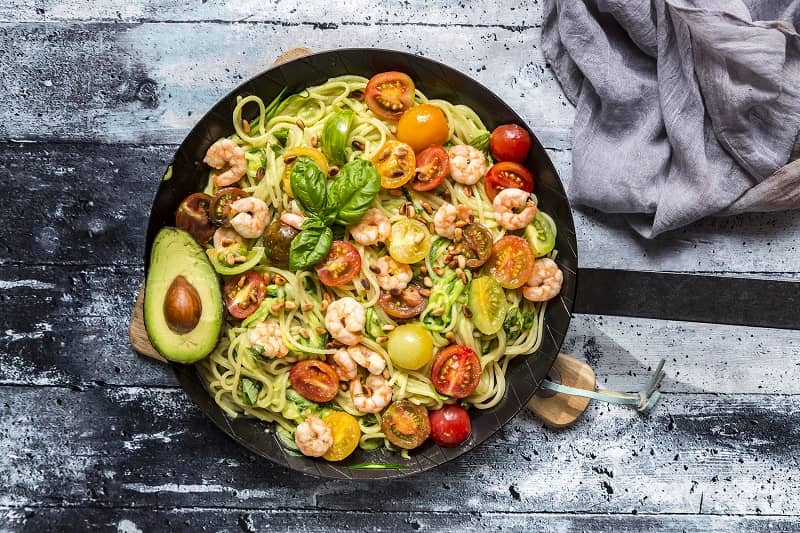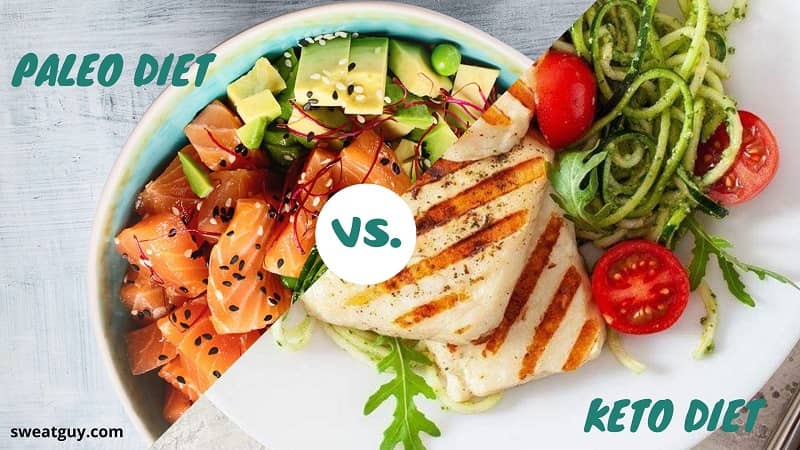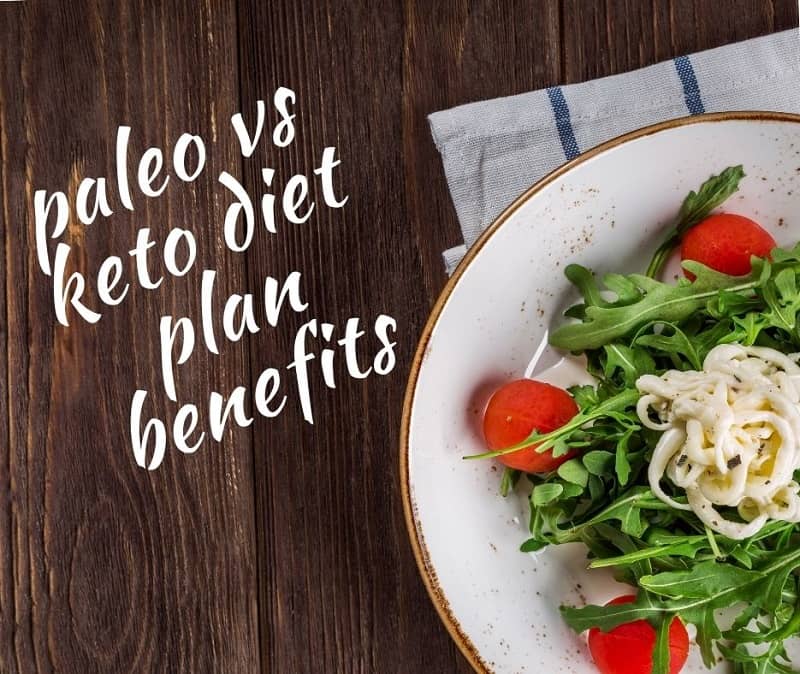Paleo and Keto diets both are very popular, but what’s the difference?
The blog covers a detailed comparison of the paleo and keto diet to know which diet is right for you…
Paleo and keto diet are two of the most trendy dietary choices to optimize metabolic health. But both are fundamentally different in their approach, food choices, and health effects.
Thus, comparing Paleo vs Keto Diet holds the key to making an informed decision between them.
Navigating through different diet plans can be fun and tiresome, both at the same time.
You have all sorts of options at your disposal to create a personalized eating schedule. Still, you wonder which one might be right for your goals.
Well, you’ve got good reason to explore paleo and keto diets if your goals involve weight loss.
In fact, most people seek these diet plans for the same reason.
This blog will investigate the similarity and Difference in Paleo vs Keto Diet plans.
Right below is the ultimate guide you need to understand the benefits, limitations, and results of the Paleo and Keto Diet Plan.
#1. The Basics of a Paleo Diet Plan

Paleo takes its name from “paleolithic” meaning the old stone age.
Essentially, it means the diet you practice under this plan belongs to our ancestors.
So, no pizza that’s lying around in your fridge!
Typically, this kind of diet plan eliminates everything that comes from modern food processing.
The idea is to depend on raw and fresh foods sourced directly from nature.
People who subscribe to paleo diets usually stay away from modern eating habits.
Rather, they eat vegetables, nuts, seeds, meat, fish, and anything else that’s unprocessed.
However, this means they cannot eat dairy, grains, or legumes either.
The takeaway here can be tapping into our evolutionary makeup for optimum health.
In fact, paleo is more of a lifestyle practice than a diet plan. People who follow it are often committed to holistic living.
The main benefits are better biological functions, digestion, and accelerated weight loss.
#2. The Basics of a Ketogenic Diet Plan
This particular diet plan focuses on helping you achieve ketosis. Thus, the name keto.
Ketosis is a metabolic state where your body resorts to calories from fat to generate energy.
Biologically, our tissues use glucose from carbs to provide fuel for normal physiological functions.

However, the keto diet naturally forces your body to use stored fat by reducing carb intake.
So, the majority of foods allowed under the diet plan comprises fats and proteins.
Keto diet is highly effective for fast weight loss as the body shifts from carbs to fat for energy. Hence, drawing on the stored fat to keep the organs functioning.
But while the keto diet is effective, it requires careful planning of macronutrients in your meals.
Even a slight slip here and there can send your metabolism out of ketosis.
So, if you plan to adopt this diet, be prepared for some calculations and meticulous meal preps.
Paleo Is About Holistic Living Whereas Keto Emphasizes Macronutrients
The main point of difference when it comes to Paleo vs Keto Diet plans is the ideology behind the practice.
Paleo is geared towards ancestral living devoid of modern-day lifestyle practices. Thus, it values the ancient way of living.
The scope of a paleo diet regimen goes beyond just your daily meal plans.
Those who adopt it follow a specific kind of lifestyle for total mind and body wellness.
In fact, it’s not uncommon to see paleo practitioners include yoga and mindfulness as a part of their daily routine.
The premise of a keto diet, though, is quite contrary. Here the focus is solely on eating a carb-deficient diet.
A Keto Diet Plan is about balancing out the nutrient profile of your meals. So, the macronutrient distribution has to account for low carb intake while upping fats and proteins.
Whereas, the paleo diet is not hyper-focused on the intake of macronutrients including carbs.
Any food is allowed as long as it doesn’t come from processed means.
So, you can still enjoy whole food sources of carbs like sweet potatoes, carrots, and winter squash.
This flexibility is obviously limited in an extremely low-carb Keto Meal Plan.
Now, let’s get into more details and see what both the diets entail.
Paleo vs Keto Diet – Similarities and Differences in Eating Habits
It’s normal to get confused while comparing Keto vs Paleo Diet.
There are a number of overlapping similarities and both diets mimic certain characteristics.
Thus, some food choices will stay intact no matter which diet plan you choose. Likewise, we also have some underlying disparities.
And the differences actually determine which diet plan will be right for you.
In this section, we’ve set out to establish the similarities and Paleo and Keto Diet Differences.

But first, here’s the main ideology behind these diet plans.
#1. Both Diets Exclude Unhealthy and Highly-Processed Foods
Both paleo and keto diets are heavily dependent on whole food sources.
Thus, they eliminate all the french fries, crackers, and other tasty but junk food items.
The common aim of both these diet routines is to improve metabolism and overall health.
And that obviously requires you to get rid of all the ultra-processed food sources.
Thus, common food items allowed in both these diet plans include:
- Fresh vegetables
- Nuts and seeds
- Unprocessed meat
- Seafood
- Eggs
- Non-starchy vegetables
However, there still is a difference in the underlying reason to pursue this kind of diet.
You see, paleo eliminates modern industrial foods because of its inherent principles. But a keto diet excludes them because of their carb content.
Moreover, eating healthy fats is an important component of both these diet plans.
This gives your body the energy to be high functioning without unnecessary calories.
Both diets encourage the intake of poly- and monounsaturated fat through seeds and fish.
While fat is an integral part of a keto diet, a Paleo Meal Plan includes it to improve overall health.
#2. Paleo vs Keto Diet: The Use of Sugar
Processed sugar is not a part of either Paleo or Keto Diet. Well, the intake of refined sugar, in general, has zero health benefits for you.
In fact, the downsides are too many to include in any diet let alone paleo or keto.
Sugar can easily cause an insulin spiking effect. Plus, it has a high carb content, which explains its elimination from a keto diet.
But why does a Paleo Diet Food List exclude sugar?
Well, you must have guessed it by now!
Because it’s a refined food item. So, white or brown sugar and corn syrup are not allowed in either of these diets.
But here’s an interesting part!
Keto will not allow any kind of sugar, whether it’s refined or unrefined.
But a paleo diet plan has room for unrefined sugar sources, such as maple syrup and honey.
This makes a keto diet quite restrictive in comparison to paleo.
Sticking to it becomes even more difficult if you’ve got a sweet tooth.
#3. No Grains and Legumes in Both Diets
Whether you decide to pursue a paleo or a keto diet, you can’t eat grains.
However, the reason for this restriction varies for both diets.
Grains and legumes were obviously not a part of the diet of early humans.
This idea prevents paleo eaters from including any type of grain in their diet.
Another reason is the anti-nutrient content in whole grains.
Compounds, such as lectins and phytates are believed to cause digestive distress in humans.
Moreover, a keto diet cuts off grains due to the fear of throwing the body out of ketosis. Foods like rice, wheat, quinoa, oats, peanut, beans, and lentils have carbs.
This means eating them doesn’t favor the breakdown of fats as the primary energy source.
Thus, defeating the sole purpose of a keto diet plan.
However, unlike sugar, quitting the intake of grains altogether may not be completely beneficial.
Whole grains have proven health benefits that you may miss out on.
#4. Paleo vs Keto Diet: Processed or Grass-Fed Meat
A strict paleo diet eliminates all processed meat in the diet as they’re not a part of early humans’ eating plan.
Well, if you think about it, it’s not such a bad idea either.
There is some research that indicates the ill effects of highly processed meat.
So, by excluding them in your diet, you’re doing yourself a favor only. But this means you cannot eat processed bacon or sausage.
On the other hand, a keto diet may allow you to eat these as long as they’re free of extra carbs.
You only have to read the labels to double-check it doesn’t contain any sugar.
Furthermore, eating grass-fed and natural meat is considered healthy for everyone.
In this aspect, a paleo diet takes a much healthier approach by eliminating any canned or industrially treated meat.
Some people still choose to have minimally processed meats.
Nevertheless, it’s a good call to avoid them and focus on good-quality meat sources.
#5. Restrictions on Eating Fruits
A Paleo vs Keto Diet Nutritional Value will vary when it comes to fruits.
Fruits are, in general, highly nutritional and a healthy choice for most people.
Though, there are some ground rules you’ve to stick to in the case of both these diets.
Let’s put it first that paleo is more flexible than a keto diet in this case too.
Paleo allows almost all fruits whether it is freshly picked or in the dried form. The only thing you should be mindful of is the sugar content.
Yes, we know sugar is usually an issue for a keto diet. But still, you don’t want to be over-indulging in a fruit that causes heavy blood sugar fluctuations.
Technically, a paleo eater has no restrictions whatsoever and can enjoy a large variety.
Just practice moderation for high-sugar fruits like mangoes and bananas.
Coming to a keto diet, you can have fruits but in a much smaller quantity.
Fruits like berries, peaches, and apples are common choices among keto followers.
#6. Consumption of Dairy and Soy Products
This is the rare case when keto is much more flexible than a paleo diet.
A keto dieter can eat almost all dairy. In fact, the keto community encourages the consumption of full-fat, unsweetened dairy.
This obviously falls in line with the keto low carb high-fat philosophy.
The only exception is ice cream and chocolate milk due to their sugar content.
But then too, you can substitute it for dairy with artificial sweeteners.
Whereas, the paleo diet doesn’t allow any dairy products except grass-fed butter.
This too is not permissible sometimes among those who strictly follow the paleo ideology.
Naturally, you cannot have any cheese, milk, butter, or cream while on a paleo diet plan.
Coming to soy products, you can have them on a keto diet as long as they meet the macronutrient allowance.
Paleo diet, again, eliminates all soy products as paleolithic humans didn’t have them.
Ideally, most people will find a suitable option in the paleo vs keto diet.
As you can see, they differ quite a bit with their own pros and cons.
Let’s have a look at the benefits to sort out which one would be a healthier choice.
Benefits of Paleo Diet vs Keto
Well, almost every diet plan has some sort of health benefits.
That’s why people follow them, right?
Though, the one that’s most suitable for you should meet your specific goals.
Here’s what we found out about paleo vs keto diet plan benefits.

#1. Benefits of Paleo Diet
This diet plan steers clear of modern eating habits and a western diet.
So, there is usually a heavy reliance on lean proteins and whole foods.
These are some of the perks that may offer you:
- Increased feeling of satiety leading to mindful eating
- Elevates the intake of healthy and nutritious food
- Prevents high blood pressure
- Can lead to reductions in the waist size
- Easier to adjust to for people with dairy or gluten allergy
#2. Benefits of Keto Diet
As opposed to paleo, a keto meal plan is solely based on macronutrient selections in meals.
Here are some of the benefits you can experience as a result:
- Suppresses cravings and appetite
- Low-carb diets lead to accelerated short-term weight loss
- Reduces blood triglycerides
- Increases HDL (good) cholesterol levels
- Very effective at reducing abdominal fat
Well, this was all about the perks.
But what about the downsides?
You do have to consider them as well for a better choice between these diets.
Paleo vs Keto Diet: Drawbacks
A paleo diet may not be as good for you if you really like dairy.
Plus, it cuts out the high nutrition you may get from protein-rich dairy products.
You also can’t have any grains or legumes, some of which are staples in many diets. This may make planning your eating routines a bit of a hassle.
However, that’s nothing when compared to a ketogenic diet, which is more restrictive in more sense than one.
As for a ketogenic diet plan, you cannot have many of the fruits due to their natural sugar and carb content.
Lowering carbs in your diet is sometimes really troublesome as well. Plus, it’s common to feel lethargic when you start out.
Moreover, sticking to the diet plan in the long-run is a task on its own. You’ve to be very calculative of your macronutrient consumption.
Well, let’s just say following keto needs you to be diligent with your eating plans.
Further, keto doesn’t allow any grains and legumes as well. Your only solace then is in unsweetened dairy products.
Key Downside of a Paleo Diet: Completely eliminates grains and almost all dairy.
Key Downside of a Keto Diet: You’ve to weigh how much carbs you consume at each meal to stay on track. It’s very easy to slip out of ketosis. Thus, defeating the purpose of the diet.
Are there also any side effects as per Paleo vs Keto Diet Results?
Well, let’s find that out!!
Are There Any Side Effects?
Both these diets can have their own side effects.
However, based on a close examination, a ketogenic eating pattern may present more difficulties.
Here are the details.
#1. Side Effects of a Paleo Diet
Lucky for you, this diet doesn’t eliminate major food groups except for dairy.
While it cuts off some sources of processed carbs, it still allows carbohydrates from whole foods.
Some possible side effects include:
- Vitamin D and calcium deficiency in the absence of dairy.
- Feeling lethargic during the first few weeks of starting the diet routine.
#2. Side Effects of a Keto Diet
Ketogenic diet plans are highly restrictive as compared to paleo.
Except for proteins and fats, it cuts out major fiber and carb sources to a large degree.
Possible side effects will show up as:
- Nausea, headache, lethargy, and decreased exercise performance as the body switches to ketosis.
- Constipation due to decreased fiber consumption.
Well, starting any new diet routine that cuts off certain food groups will always show some effects.
Unfortunately, these changes will also include some undesirable aspects.
Those with chronic health conditions should always ask their doctor before taking up a new diet.
Plus, monitor your health closely to make sure you don’t get critically malnourished or lack essential nutrients.
If need be, your doctor may recommend you take nutritional supplements to compensate for the lack.
Irrespective of all these facts, one thing that’s certain is these diets are going to help you get in shape.
Both paleo and keto dieters subscribe to the idea of healthy and conscious eating.
There are some studies indicating short-term weight loss benefits with both these diets.
Paleo Diet vs Keto Diet for Weight Loss – Which One Is Fast-Acting?
One of the primary reasons for the popularity of paleo and ketogenic diets is weight loss.
Or else, we wouldn’t be discussing these diet plans at length today.
As a matter of fact, we need more conclusive research to establish their weight loss benefits.
However, some research does show promising weight loss results.
Let’s see how the paleo vs keto diet performs in comparison.
A study conducted on postmenopausal, obese women showed 9% weight loss after 6 months of following the paleo diet. Further, this same group had a 10.6% weight loss at 12 months.
Some data also suggests the benefits of the paleo diet in improving metabolic health.
As for the ketogenic diet, the benefits have been outlined as follows.
Low-carb, high-fat diets are usually beneficial for rapid short-term weight loss.
You see, a keto diet is based on science and follows the fundamental rules of calorie restrictions.
For one, the higher fat consumption keeps you full for longer leading to less caloric intake. Plus, you burn fat at a faster rate as the body taps into fat stores for energy.
Moreover, there can also be a difference in Paleo vs Keto Weight Loss duration. Paleo diets are more flexible and allow for more food options.
So, this may slow down the result time. But, on the other hand, it’ll also be easier to maintain your results in the long-run.
A ketogenic diet will almost certainly offer rapid results. But it is tougher to keep at it due to so many dietary restrictions.
It’s basically a trade-off and the choice rests with you!
So, what’s the bottom line here?
Paleo vs Keto Diet – Which Is a Healthier Solution?
Both paleo and keto diets have their own upsides and downsides.
As a result, there’s no universal answer to the Paleo Diet vs Keto Diet Which Is Better debate.
It is, in fact, a part of ongoing discussion in the health community. Some will prefer paleo over keto while others prefer the opposite.
However, one thing that’s for certain is the need to choose your dietary habits as per your current health, willingness to abide by the rules, and fitness goals.
The limitations of a ketogenic diet may not suit everyone. Paleo is more often than not a better alternative for people who need flexibility.
However, a keto diet can dramatically improve insulin sensitivity and weight loss prospects.
Many people actually balance the two to get their desired results. Though, make sure you meet your RDI and are not deficient.
Consult your doctor before making sudden changes to come up with the best solution.
The best diet for you is almost always the one you can stick to without physical and mental distress.
Now, we would love to know what you think and if you’ve ever tried any of these diets.